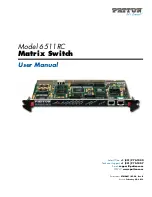
D-Link DGS-1005D Unmanaged Gigabit Ethernet Switch
Mapping QoS on the Switch
The picture above shows the default priority setting for the Switch. Class-3 has the highest priority of the four priority
queues on the Switch. In order to implement QoS, the user is required to instruct the Switch to examine the header of a
packet to see if it has the proper identifying tag tagged. Then the user may forward these tagged packets to designated
queues on the Switch where they will be emptied, based on priority.
"The DUT support strict mode for 802.1p QoS. The untagged pkt will follow the priority 0 to work (i.e. class 1)."
Understanding QoS
The Switch has four priority queues. These priority queues are labeled as 3, the high queue to 0, the lowest queue. The
eight priority tags, specified in IEEE 802.1p are mapped to the Switch's priority tags as follows:
Priority 0 is assigned to the Switch's Q1 queue.
Priority 1 is assigned to the Switch's Q0 queue.
Priority 2 is assigned to the Switch's Q0 queue.
Priority 3 is assigned to the Switch's Q1 queue.
Priority 4 is assigned to the Switch's Q2 queue.
Priority 5 is assigned to the Switch's Q2 queue.
Priority 6 is assigned to the Switch's Q3 queue.
Priority 7 is assigned to the Switch's Q3 queue.
The Switch uses strict priority for Scheduling. Strict priority-based scheduling, any packets residing in the higher priority
queues are transmitted first.
D-Link’s Green Technology
D-Link’s Green Technology implements special power-saving features under speed at 1000Mbps that detect cable length
and link status and adjust power usage accordingly.
Green Ethernet Technology saves energy in two specific ways:
Method 1: If there is no link on a port, such as when there is no computer connected to the port or the connected computer
is powered off, Green Ethernet Technology will enter a "sleep mode", drastically reducing power used for that port.
Method 2: D-Link Green Ethernet detects the length of connected Ethernet cable and adjusts power usage accordingly
without affecting performance. This way, a port connected to a less than 20m cable only uses as much power as it needs,
instead of using full power, which is only needed for 100m cables.
Switching Technology
Another key development pushing the limits of Ethernet technology is in the field of switching technology. A switch
bridges Ethernet packets at the MAC address level of the Ethernet protocol transmitting among connected Ethernet or fast
Ethernet LAN segments.
Switching is a cost-effective way of increasing the total network capacity available to users on a local area network. A
switch increases capacity and decreases network loading by making it possible for a local area network to be divided into
different
segments
that do not compete with each other for network transmission capacity, decreasing the load on each
segment.
The switch acts as a high-speed selective bridge between the individual segments. Traffic that needs to go from one
segment to another (from one port to another) is automatically forwarded by the switch, without interfering with any other






































